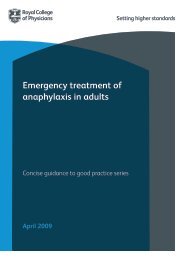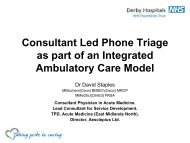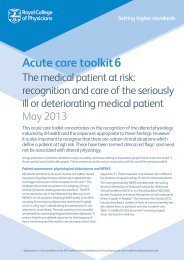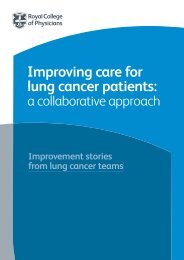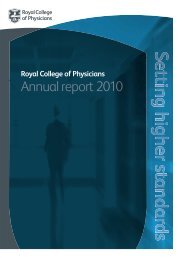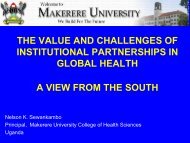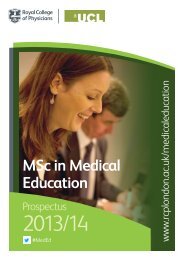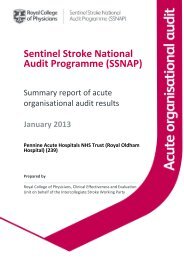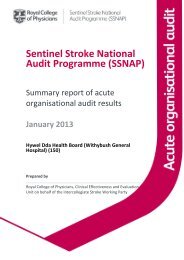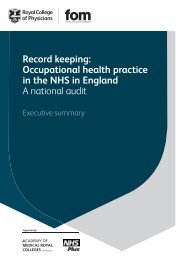Consultant physicians working with patients - Royal College of ...
Consultant physicians working with patients - Royal College of ...
Consultant physicians working with patients - Royal College of ...
Create successful ePaper yourself
Turn your PDF publications into a flip-book with our unique Google optimized e-Paper software.
2 Specialties Acute internal medicine and general internal medicineDetailed recommendations for the implementation <strong>of</strong>7-day consultant <strong>working</strong> in the AMU are made in theRCP Acute care toolkit 4: 12-hour, 7-day consultantpresence on the acute medical unit. 15With the on-call consultant present in the hospital for12 hours daily, typical hours <strong>of</strong> work would be from8am to 8pm. During the <strong>working</strong> week, this predictableemergency work would represent three sessions <strong>of</strong> PAsin direct clinical care, mainly in non-premium time.Similar <strong>working</strong> on weekends and during holidays, inpremium time, would represent four sessions <strong>of</strong> PAs indirect clinical care.<strong>Consultant</strong> work patterns should include protectedsessional time for AMU work, ideally in blocks <strong>of</strong> days.Single-day rotas contribute to poor continuity <strong>of</strong> carebut 7-day blocks are considered too onerous. Precisework patterns should be developed to reflect local needs.All other clinical duties and responsibilities should becancelled for all clinical staff <strong>working</strong> on AMU orparticipating in the direct supervision <strong>of</strong> the acutemedical intake. 2,13 A consultant’s eligibility to continueparticipating in the acute take should be assessedannually during his or her appraisal. Theserecommendations are equally applicable where theintake is managed by an acute physician or by aphysician <strong>with</strong> another specialty interest who isqualified to lead the acute medical intake.The work <strong>of</strong> an acute physicianAcute medicine is a young discipline, and as such itsstyle <strong>of</strong> <strong>working</strong> is still in evolution. However, it isapparent that there is more opportunity for variety <strong>of</strong>practice in acute medicine than in many otherspecialties. Classic acute <strong>physicians</strong> will normally haveaccess only to beds on the AMU, where their <strong>patients</strong>’length <strong>of</strong> stay is usually limited to between 24 and 72hours. Acute <strong>physicians</strong> are therefore able to manage thetotal episode <strong>of</strong> care <strong>of</strong> <strong>patients</strong> who do not require alonger admission. Managing <strong>patients</strong> in the AMU, or itsrelated short-stay unit, is beneficial in minimising thenumber <strong>of</strong> ward-to-ward transfers which are disruptiveto care. The acute physician should also have time tomanage alternative strategies to admission, such asambulatory emergency care and rapid access clinics.In addition to work on the AMU, the RCP recognisesthe value <strong>of</strong> the acute physician in ensuring closerelationships <strong>with</strong> all medical specialties and <strong>with</strong>emergency medicine and critical care. 10,11 Sessionalwork in either <strong>of</strong> these fields would be appropriate foracute <strong>physicians</strong> who have the required competencies.Similarly, it may be appropriate for an acute physicianto retain an interest in another discipline in which he orshe has demonstrated the relevant competencies, such asthoracic medicine or gastroenterology, or in proceduressuch as echocardiography. This can be maintained bycontinuing sessional work in that field. Other modelsexist where a significantly greater proportion <strong>of</strong> <strong>working</strong>time is spent in another discipline or where there is acycle <strong>of</strong> differing activities, such as <strong>working</strong> for periods<strong>of</strong> one or more weeks in acute medicine andsubsequently similar periods in another discipline.All acute <strong>physicians</strong> should have the competencies todeliver high dependency care to most <strong>patients</strong> <strong>with</strong>medical needs defined as level 2 by the Intensive CareSociety. 8,25 In some hospitals, a medical highdependency unit could be embedded <strong>with</strong>in the AMU. 2Inpatient workThe usual day-to-day work <strong>of</strong> an acute physician caninclude a formal contribution to the supervision <strong>of</strong> theacute medical intake as the sole responsible consultantfor a period <strong>of</strong> time. Alternatively, an acute physicianmight work together <strong>with</strong> another consultant, seekingthe more severely ill <strong>patients</strong> for early assessment or<strong>patients</strong> suitable for management as short-stay orambulatory emergency care <strong>patients</strong>. Where a number<strong>of</strong> acute <strong>physicians</strong> are in post, their contribution to thesupervision <strong>of</strong> the acute medical intake will obviouslybe greater.Outpatient workOutpatient work in acute medicine is divided betweenrapid access clinics, which usually <strong>of</strong>fer same-day ornext-day appointments for selected <strong>patients</strong>, andambulatory emergency care. In the outpatient service,the numbers <strong>of</strong> <strong>patients</strong> seen should follow therecommendations for a number <strong>of</strong> specialties –approximately 30 minutes should be allocated for a newpatient and 15 minutes for a follow-up appointment. Inambulatory care, it is more difficult to define setnumbers because the <strong>patients</strong> managed in this way aremore varied.The work <strong>of</strong> a general physicianGeneral internal medicine is the origin <strong>of</strong> many medicalspecialties and is at the heart <strong>of</strong> <strong>physicians</strong>’ work. Thereare two components to the work <strong>of</strong> a general physician:the immediate care <strong>of</strong> the acutely ill medical patient andthe longer-term management <strong>of</strong> some <strong>of</strong> these <strong>patients</strong>.C○ <strong>Royal</strong> <strong>College</strong> <strong>of</strong> Physicians 2013 21



